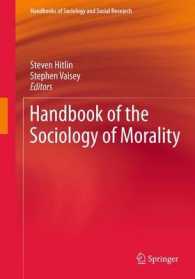Full Description
This book critically examines the ways in which translation studies can offer a conceptual framework for understanding and researching international affairs, drawing on examples from China's Belt and Road Initiative.
The volume encourages new conceptualisations of our understanding of culture and communication through the lens of translation, re-envisioning translation beyond the scope of the global circulation of cultural products. Tian explores the case study of the Belt and Road Initiative to show how nation branding and soft power can be understood through a translational lens if we rethink of translation as the means by which cultures communicate and build relationships with each other while retaining their distinct dimensions. In focusing on intertwining concepts across translation studies, cultural studies, and international relations - universalism, power, identity, and development - the book showcases how it is a useful framework for understanding how translation studies can serve as a platform for multidisciplinary dialogue on a global scale.
This book will be of interest to scholars in translation studies, cultural studies, international relations, and Asian studies.
Contents
Contents
Acknowledgements
Introduction
0.1 Purpose
0.2 Main thesis of the book
0.3 Chapter overview
Chapter 1 Map-Sketching as an Interdisciplinary Method: Against Map, Linearity, and Mastery
1.1 Map and power: Inspirations from critical cartography
1.1.1 Critical cartography, maps, and power
1.1.2 The map of TS and its problems
1.2 Sketch map as a method: Line, meshwork, and rhizomatic epistemology
1.2.1 Sketch map and lines of a meshwork
1.2.2 Rhizome
1.2.3 Serendipity and translation
1.3 Conclusion
Part I: Culture as Defined by Translation
Chapter 2 Culture as Meaning Making
2.1 Culture as a lifestyle
2.2 Culture as a system
2.3 Culture as signs and meanings
Chapter 3 Culture function and translation
3.1 Culture differentiates
3.1.1 An anthropological account
3.1.2 A sociological account
3.2 Culture assimilates
3.2.1 Cultural assimilation
3.2.2 Deculturation and acculturation
3.2.3 Cultural fusion
3.3 Overview of culture function: Re-examining globalisation, deculturation, and glocalisation
3.3.1 Globalisation as cosmopolitanism
3.3.2 Globalisation as deculturation
Entanglement 1: Culture and Translation
Part II: Soft Power, Nation Branding, and Translation
Chapter 4 Power and Translation
4.1 Defining power
4.2 Soft power and translation
4.2.l Culture as the resource for soft power
4.2.2. Instruments of soft power
4.2.3 Overview: soft power and translation
Chapter 5 Nation Branding as Translation
5.1 Constructability of national identity
5.2 Branding
5.3 Nation branding
5.3.1 Nation branding compared with commercial branding
5.3.2 Nation branding conveying national identity: Nation branding as touching
5.3.3 Soft power as a resource for nation branding: Nation branding as communication and development
Entanglement 2: Translation, Power, and Branding
Part III: China's Nation Branding as Translation
Chapter 6 Introduction to the BRI: A Geo-Economic, Geo-Political, Geo-Cultural, or Interconnective Initiative?
6.1 The BRI as a geo-economic initiative
6.2 The BRI as a geo-political initiative
6.3 The BRI as a geo-cultural initiative
6.3.1 The BRI and the concept of He: The peace-building and interconnectivity outlook of the BRI
6.3.2 The BRI as eco-translation
Chapter 7 The "What" Question: Framing, Reframing, and Stereotypes
7.1 Translation as framing
7.2 Framing in nation branding
7.2.1 Framing as stereotyping
7.2.2 Framing as selecting information
7.2.3 Framing in the BRI: Framing history as an example
7.3 Conclusion: Framing the Silk Road as translatio studii et imperii
Chapter 8 The "Who" Question: Translation and Identity in China's Nation Branding
8.1 Self and otherness
8.2 The self and otherness in TS
8.3 The self and otherness for China
8.3.1 A philosophical exploration
8.3.2 An anthropological exploration
8.4 The self and otherness in BRI branding
8.4.1 From the periphery to the centre
8.4.2 Who is allowed to translate?
8.5 Conclusion: Choose translators with otherness in mind
Chapter 9 The "How" Question: How do Nations Communicate their Brands to Others?
9.1 Development communication: An overview
9.1.1 Empowerment
9.1.2 Participatory development
9.2 Development communication and nation branding
9.3 Development communication in the BRI
9.3.1 China's communication for development: The case of Confucius Institute
9.3.2 China's communication about development
9.3.3 China's communication of development
9.4 Conclusion: Development translation
Entanglement 3: Who, what, and how to brand a nation from a translational perspective
Chapter 10 Translation Studies as Knowledge, Method, and Meta-Discipline
10.1 Revisiting research questions
10.1.1 Translation as connection
10.1.2 Translation as differentiation and assimilation
10.1.3 Translation as criticism of authority
10.1.4 Translation as a process rather than a product
10.2 Implications
10.2.1 Translation knowledge
10.2.2 Translation as a method
10.2.3 TS as a meta-discipline
10.3 Potential for future research
Bibliography
Index








